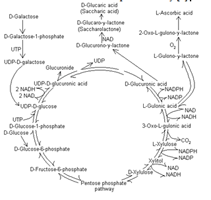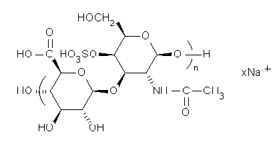Meet Androgenic: Shawn Wells, MPH, RD graduated magna cum laude from the prestigious business specialty school, Babson College with a Bachelor's degree in Business Administration. Reading a book, Optimum Sports Nutrition by Dr. Michael Colgan, along with lifting weights, playing basketball and working at a popular nutrition store changed his direction.

Post-graduate work with UNC Greensboro in Exercise Sports Science, Nutrition, and Biochemistry reinforced his passionate pursuit. This work led to admission to UNC Chapel Hill in the Master's program. During his study at Chapel Hill he interned with the School of Medicine in the groundbreaking Nutrition in Medicine project, a series of interactive software modules employed at every medical school in the country.
He contributed on the Dietary Supplements module for this project using his expertise in sports nutrition. He graduated from UNC Chapel Hill with his Master's of Public Health in Nutritional Science and after a number of clinical rotations obtained the certification of Registered Dietitian (RD).
Working in acute care as a Chief Clinical Dietitian as well as rehabilitation/long-term care, he furthered his clinical work. Shawn presently practices as a Clinical Nutrition Manager as well as private consulting work in the Charlotte, NC area.
Email Shawn anytime at androgenic@mansports.com

Glucuronolactone & The Athlete
 What Is Glucuronolactone?
What Is Glucuronolactone?
Maybe the odd sounding compound rings a bell, maybe it doesn't. It is something you have probably consumed if you have ever had an energy drink. It is also quickly being adopted in the supplement world, typically in multiple ingredient ergogenic (performance enhancing) or pre-workout products.
There is relatively little information on the compound, which has led to a lack of awareness about its effects and even misinformation to the athletic community.
D-Glucurono-γ-lactone, or in organic chemistry nomenclature, D-glucurono-3,6-lactone (henceforth referred to as DGL) is a natural metabolite of glucose and regulates the formation of glycogen. Its precursor, D-glucuronic acid (henceforth referred to as DGA) remains in an equilibrium state with glucuronolactone at physiological pH.
Therefore at any given time the compounds can convert back and forth to remain balanced in a 50/50 ratio (fig. 1) endogenously (in the body).
The fact that the two compounds, DGL and DGA, are physiologically interchangeable opens up much empirical and research-based data on what DGL is and what its benefits (or potential risks) may be to you, the athlete.
 Is It Safe?
Is It Safe?
DGL can be found in minute amounts naturally, with wine being the highest source at 20mg/l. Energy drinks average 2000-2400mg/l of DGL, a difference of 100-120 fold [1]. A number of studies have yielded that even at high dosages the compound is relatively safe using a number of animal models.
Concentrations as high as 20,000-mg/kg bodyweight with the rat model via oral administration yielded the measure of acute toxicity, LD50, or the dose of lethality for 50% of the animals exposed. In a 100kg (220 lb.) male this would equate to 2000g or 2kg2.
Research has also indicated that DGL is quickly absorbed, metabolized and excreted as glucaric acid, xylitol (a sugar alcohol), and L-xylulose (a sugar) in the urine1. So we can assume the compound is safe at supplemental dosages (e.g. 500-3,000 mg.) and clearance time is short-lived in the human model, further reinforcing that assumption.
The highly scrutinizing, research-based document by the European Commission studying the safety of energy drinks and their components, including glucuronolactone, examined toxicokinetics (fate of the compounds in the body) and toxicodynamics (their imparted effects)3.
"Consideration of the chemical nature of the three parent components and their metabolites, and the fact that differing processes are involved in their absorption, distribution, metabolism and excretion did not, in the expert's view, raise any a priori reasons to expect any toxicokinetic interactions, even at high intakes of any constituent.
This was supported by known physiology and citation of existing studies." This said, there is a lack of studies on human models measuring toxicity with DGL and additional research could solidify the aforementioned assertion.
 Is It Liver-Protective?
Is It Liver-Protective?
DGL is most likely hepatoprotective, meaning it will reduce ill effect or even improve the physical state and function of the liver. In a Chinese research study using an herbal concoction called gan-xian-fang, of which DGL is a component, they measured a marked improvement in patients with hepatic fibrosis resulted from hepatitis B4.
This study was a double-blind controlled trial funded by the Chinese Ministry of Public Health and published in the Chinese Medical Journal giving scientifically valid results. This research is not conclusive, given that DGL is not isolated for its actions, but it does reinforce of potential benefits and safety.
 Is It Ergogenic? Is It Drug/Toxin Protective?
Is It Ergogenic? Is It Drug/Toxin Protective?
The liver is where the metabolism of glucose begins enzymatically (figure 2)5. DGA, in the UDP-glucuronic acid form, is created in the liver of every animal, including primates. This compound will conjugate toxins, making them more hydrophilic or water-soluble allowing for effective elimination.
This reaction is catalyzed by the enzyme UDP-Glucuronyltransferase. Conversely another enzyme, glucuronidase, breaks apart conjugates (glucuronidases) to free hormones and other chemicals to be used endogenously6, 7. Some intestinal flora (indigenous bacteria) can produce this enzyme allowing a lipophilic (fat-soluble) toxin or drug to be eliminated via feces or urine.
Therefore UDP-Glucuronic acid is known to have three functions: detoxification through conjugation, free hormones and other substances via deconjugation, and as a step to biosynthesis of L-ascorbic acid (Vitamin C) in animals (except primates and Guinea pigs).
One study that measured the depletion of UDP-glucuronic acid by drugs which are glucuronidated (e.g. salicylamide, clofibric acid, valproic acid and chloramphenicol) yielded a depletion of UDP-glucose and glycogen by over 50% with administration of these drugs8, 9.
Essentially these drugs are utilizing this compound more rapidly than it is produced, thereby decreasing other compounds (e.g. glycogen) in its pathway. Glycogen is the stored muscle (and liver) carbohydrate used preferentially during exercise.
It can be concluded that some drug use can decrease performance in regard to glycogen. Therefore supplementation with DGL may, in fact be an ergogenic aid by allowing their synthesis and ultimately their utilization in exercise 10, 11.

 Click Image To Enlarge.
Click Image To Enlarge.
Figure 2. D-Glucurono-γ-lactone (DGA) & D-Glucuronic Acid's Biochemistry Illustrated Via The Pentose Phosphate Pathway5
 Are There Any Misconceptions Out There?
Are There Any Misconceptions Out There?
There has been some research out there that has been misinterpreted. Erroneous statements about DGL are inevitable given the lack of print dedicated to the compound at this point paired with its growing popularity in new supplement formulations. The following two studies have been referenced in listing DGL's potential benefits to the athlete and require closer examination.
A study done with canines to measure the amount of insulin stimulation with DGL administration has led to other articles reporting this as a potential benefit. The study was predicated on the knowledge that DGL converts to xylitol via the glucuronate-xylulose cycle.
Xylitol is a potent stimulator of insulin secretion and the study would test if DGL is as well. The canines were injected with an IV DGL shot at 400mg/kg bodyweight. The effect on insulin was small when compared to xylitol or even glucose, leading one to believe that DGL is not effective in this manner12.
One caveat to that is canines synthesize L-ascorbic acid (Vitamin C) endogenously and some of the DGL may have been diverted to that pathway. An intuitive follow-up study would use Guinea pigs or primates (which cannot synthesize vitamin C), thereby reinforcing the study's original assertion and eliminating the alternate possibility.
Another study on the effect of cellular ascorbic acid levels, an oxidation (free radical cell damage) marker, post-exercise in rats led some authors to apply this data to the human model13. As mentioned, many animals synthesize L-ascorbic acid endogenously and do not require supplementation/dietary intake to prevent deficiency.
DGL can be diverted to this pathway in rats to increase the biosynthesis of L-ascorbic acid. This would not be the case in the human model. The results of the study, while affirming the biochemistry of the compound and its ultimate fate, cannot be applied to the athlete.
 Is It Beneficial For Joints & Tendons?
Is It Beneficial For Joints & Tendons?
Chondroitin Sulfate A (CSA) is a widely available joint supplement on the market. CSA (fig. 3) belongs to a family of heteropolysaccharides called glycosaminoglycans (GAGs), also known as mucopolysaccharides. The compound is composed of linear repeating units of D-glucuronic acid (DGA) and N-acetyl-D-galactosamine (GalNAc) with sulfate groups attached at the 4 or 6 carbon.
Cartilage's elasticity and tensile strength is derived from chondroitin sulfate proteoglycans binding covalently in the extracellular collagen matrix. DGA is therefore an essential component of cartilage, ligaments and tendons. It is difficult to assert whether supplementation may elicit pro-joint/tendon effects, but it is plausible given the biochemistry.
 What About Functional Energy Drinks (FEDs), Such As Red Bull®?
What About Functional Energy Drinks (FEDs), Such As Red Bull®?
There have been three recent studies that measured the effects and efficacy of FEDs in different scenarios. Numerous supplement companies and retailers quote these studies when speaking of DGL. The inherent flaw with these studies is deducing the effect of DGL without controlling for caffeine and taurine.
Both compounds have documented effects on performance and counteracting fatigue. Nonetheless, they are of interest and noteworthy in the context of this article.
One study evaluated the effect of FEDs in counteracting driver sleepiness and concluded that they did reduce driver sleepiness and "driver-related incidents" with sleep restriction in monotonous driving environments14, 15. Empirically, most anyone walking out of convenience store could relay this, so the data is not surprising.
The next study evaluated FEDs on mood, memory and information processing on humans. The study controlled for sugar using a formula with sugar in one test group and a sugar-free in another. The sugar vs. sugar-free groups had no significant difference in test performance16. The FED vs. placebo did show improved attention and verbal reasoning. Interestingly, this study showed no illicit effect on memory recall.
A third study assessed psychomotor performance (reaction time, concentration, and memory), subjective alertness and physical endurance using FEDs (specifically Red Bull®). There was a statistically significant gain in aerobic and anaerobic performance using cycle ergometers.
Improvements in mental performance with increased reaction time, concentration and immediate recall were noted. This study would reinforce the data that FEDs increase alertness17.
 What Would Be The Correct Dosing?
What Would Be The Correct Dosing?
One place to extrapolate data from is a long-term study of glucuronolactone therapy in chronic carriers of the typhoid organism. The compound's ability to inhibit viral and bacterial β -glucuronidase made it efficacious therapeutically. The authors stated that administration of between one and three grams per day did not lead to any short or long-term health problems18.
Given the research and anecdotal data these dosages are probably safe even with chronic supplementation1, 19. When compared to DGA, DGL is significantly more metabolically active via oral administration through GI tract absorption and would therefore be preferential over DGA as a dietary supplement20.

Discussion & Final Thoughts
Internet user reviews supplementing with 1-3 grams of DGL in its pure, powder form, typically report positive results in terms of perceived energy and alertness. This would be the dosage I would recommend to the athlete desiring to supplement with DGL. This dosing is predicated on the safety data foremost, which is considerable.
It should be noted that Red Bull® has 600 mg. of DGL, but also has other substances that may work in additive or synergistic fashion (e.g. caffeine, taurine, B-vitamins) that may necessitate a lower dose to yield the desired effects.
DGL is a fascinating compound and appears not only to be safe, but hepatoprotective. A pathway of interest is the clearance of toxic metabolites and liberation of lipophillic steroids. DGL may increase the bioavailability of an exogenous hormone being administered, thereby increasing the direct effect elicited.
Moreover, the compound could remove metabolites that could potentially be hepatotoxic and may reverse prior liver damage. DGL may also be an ergogenic aid by protecting glycogen stores and their synthesis. Lastly, it may be joint and tendon protective benefiting the athlete by potentially reducing risk of injury and associated pain.
This fully referenced article should serve as an exhaustive resource for the athlete, through scientifically-based research and theory. I would appreciate feedback from readers that have supplemented with the compound (especially in its pure form) on its performance, liver and joint benefits (or lack of).
Authors Note/Disclaimer:
As a health professional, I am by no means condoning drug use. Furthermore, MAN Sports does not. It is a reality that they will continue to be used by competitive athletes. Rather, as a scientist, I search for answers on compounds such as DGL.
This research includes its biochemical interaction, effect, safety and overall efficacy. If it is truly ergogenic, safe and even protective than this would be a significant contribution to the communal knowledge in competitive athletics.
Finally, I would like thank God, my family, friends and Joey for this opportunity and continued support.
but of power and of love,
and of a sound mind." (2 Tim 1:7 KJV)
References
- The Evaluation of the Health Aspects of D-glucurono-g -lactone as a Food Ingredient. Prepared by Arendt Fox Kintner Plotkin and Kahn, Washington DC, USA, for Red Bull GmbH, Austria. November 8, 1996.
- Register of Toxic Effects of Chemicals 1996.
- Opinion on Caffeine, Taurine and D-Glucurono-γ-Lactone as constituents of so-called "energy" drinks. European Commission. Jan 21, 1999. [ online ]
- XU Ruiyun 许瑞云, LING Yunbiao 凌云彪, YANG Hongzhi 杨宏志, WANG Zhuangliu 汪壮流 and QIU Wangshou 邱万寿. The Curative Effects of Gan-xian-fang for the Treatment of Hepatic Fibrosis Resulted from Hepatitis B : A Prospective and Randomized Double Blind Controlled Trial. Chin Med J 2001;114(10):174-186
- 5. Norbert Hoffman. The Ubiquitous Co-Enzyme UDPGlucuronic Acid Detoxifying Agent in Kombucha Tea ? [ online ] Figure adapted from Levine, R. Pharmmocology: Drug actions and reactions. Little, Brown and Co., Boston. 1978.
- Dutton, G.J., and Storey I.D.. "Uridine Compounds in Glucuronic Acid Metabolism. I. The Formation of Glucuronides in Liver Suspensions," Biochem J 57.2 (1954) : 275-83.
- Dutton, G.J., "Raising the Colors: Personal Reflections on the Glucuronidation Revolution 1950-1970," Drug Metab Rev 29.4 (1997) : 997-1024.
- Dutton G. Glucuronidation of drugs and other compounds.CRC Press. Boca Raton. 1980.
- Dutton G. Ed. Glucuronic acid, free and combined: chemistry, biochemistry, pharmocology, and medicine. Academic Press. New York. 1966.
- Tamura, S., "Metabolism of Glucuronic Acid in Fatigue Due to Physical Exercise," Jpn J Pharmacol 16.2 (1966): 138-56.
- Trahan, L., "Glucuronolactone and Glucose Metabolism in Rat Adipose Tissue," Rev Can Biol. 29.1 (1970) : 7-
- Kuzuya, T, et al., "Effects of D-Glucuronolactone, L-Gulonolactone and Penitols on Insulin Secretion in Dogs," Endocrinol Jpn 20.4 (1973) : 369-74.
- Tamura, S., "Effects of Glucuronolactone and the Other Carbohydrates on the Biochemical Changes Produced in the Living Body of Rats by Hard Exercise," Jpn J Pharmacol 18.1 (1968) : 30-8.
- Reyner LA, Horne JA. Efficacy of a 'functional energy drink' in counteracting driver sleepiness. Physiol Behav. 2002 Mar;75(3):331-5.
- Horne JA, Reyner LA. Beneficial effects of an "energy drink" given to sleepy drivers. Amino Acids. 2001;20(1):83-9.
- Alford C, Cox H, Wescott R. The effects of red bull energy drink on human performance and mood. Amino Acids. 2001;21(2):139-50.
- Seidl R, Peyrl A, Nicham R, Hauser E. A taurine and caffeine-containing drink stimulates cognitive performance and well-being. Amino Acids. 2000;19(3-4):635-42.
- Kahler V and Schmid W (1980). Die Behandlung gesunder Salmonellen-Dauerausscheider (Enteritis typhi Salm.) mit Glukuronsaure-Gamma-Lakton. Therapiewoche 30, 2831-2833
- Ahrens RA, Douglass LW, Flynn MM and Ward GM (1987). Lack of effect of dietary supplements of glucuronic acid and glucuronolactone on longevity of the rat. Nutrition Research 7, 683-688.
- Hodas, J. H., et al., "Treatment of Rheumatic Diseases with Glucuronic Acid," Lancet 69 (1949) : 385.


